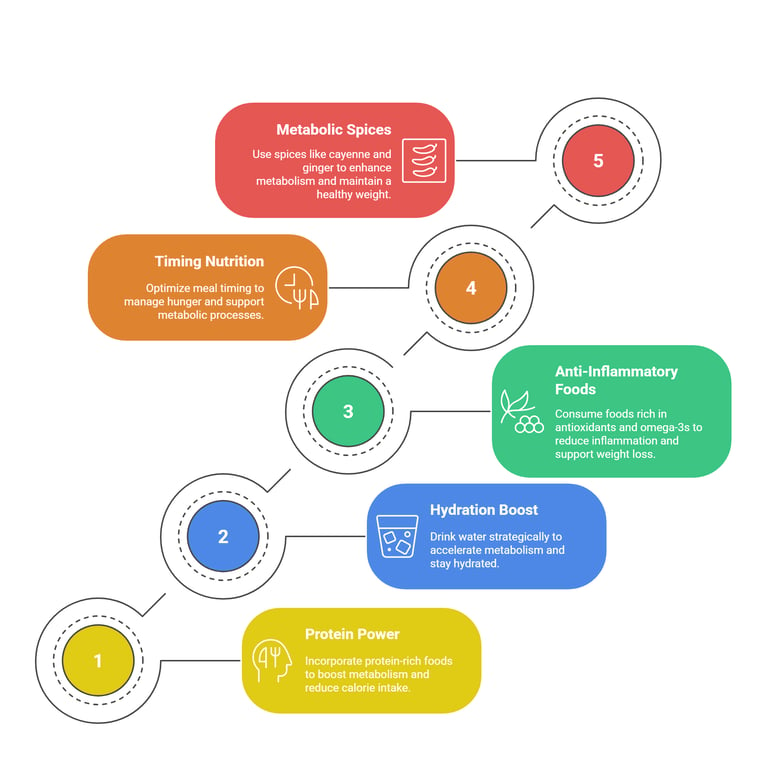Nutrition Tips for Weight Loss After 30: Your Complete Guide to a Faster Metabolism
Discover proven nutrition strategies for weight loss after 30. Learn how to boost metabolism, balance hormones, and create sustainable eating habits for long-term success.
Daryn B
7/15/20256 min read


Losing weight after 30 feels different. Your metabolism isn't what it used to be, your schedule is packed, and those late-night pizza binges seem to stick around longer than they did in your twenties. But here's the good news: understanding how your body changes after 30 can actually give you the upper hand in your weight loss journey.
Understanding Your Changing Metabolism
After 30, your body undergoes significant changes that affect weight loss. Your metabolism naturally slows as you age, reducing the number of calories your body burns at rest, making it crucial to adapt your nutrition strategy accordingly.
Think of your metabolism like a car engine. In your twenties, you had a sports car that could burn fuel quickly and efficiently. After 30, you're working with a more sophisticated vehicle that requires premium fuel and regular maintenance to perform optimally.
Key Changes After 30:
Hormonal Shifts Your hormones become the silent conductors of your weight loss symphony. Insulin sensitivity decreases, making it harder to process carbohydrates efficiently. Cortisol levels can spike more easily from stress, leading to stubborn belly fat storage.
Muscle Mass Decline Starting around age 30, you lose approximately 3-8% of muscle mass per decade. Since muscle tissue burns more calories than fat tissue, this directly impacts your metabolic rate.
Inflammatory Response After 30, the risk of chronic inflammation increases, which can hinder weight loss. Your body becomes more sensitive to inflammatory foods, making nutrition choices even more critical.
Strategic Nutrition Approach for Weight Loss After 30
1. Protein Power: Your Metabolism's Best Friend
Protein becomes your secret weapon after 30. In one 2005 study, consuming 30% of calories from protein caused people to automatically drop their calorie intake by 441 calories per day.
How to Optimize Protein Intake:
Aim for 25-30 grams of protein at each meal
Include protein sources like lean meats, fish, eggs, legumes, and Greek yogurt
Consider having a protein-rich breakfast to kickstart your metabolism
Real-Life Example: Sarah, a 32-year-old marketing manager, struggled with afternoon energy crashes. By adding a protein smoothie with Greek yogurt and berries to her breakfast, she noticed sustained energy and reduced cravings throughout the day.
2. Hydration: The Overlooked Metabolism Booster
Water isn't just for hydration anymore; it's a metabolism accelerator. Researchers found that drinking 16.9 ounces (a little over 2 cups) of water increased metabolic rate by 30 percent for 30 to 40 minutes.
Actionable Hydration Strategy:
Drink 500ml of water upon waking
Consume water before each meal
Opt for cold water when possible for an extra metabolic boost
3. Anti-Inflammatory Foods: Your Weight Loss Allies
Foods rich in antioxidants and omega-3s, such as berries, nuts, fatty fish, and leafy green vegetables, help reduce inflammation and support the weight loss process.
Weekly Meal Planning Framework:
Monday-Wednesday: Focus on fatty fish like salmon or sardines
Thursday-Friday: Incorporate colorful berries and leafy greens
Weekend: Prepare anti-inflammatory meals with turmeric and ginger
4. Timing Your Nutrition for Maximum Impact
Breakfast Optimization: Some newer studies show that moving some protein from supper to breakfast can help with weight management by decreasing hunger and cravings throughout the day. Front-loading your protein intake can set you up for success.
Evening Eating Strategy: Create a cutoff time for eating, typically 3 hours before bed. This allows your body to focus on repair and recovery rather than digestion during sleep.
5. Metabolic Boosting Foods and Spices
Eat spicy foods, (include ginger, garlic, chilli peppers, cinnamon, turmeric, etc while preparing meals) it could be beneficial for boosting your metabolism and help you maintain a healthy weight.
Spice Cabinet Essentials:
Cayenne pepper: Increases thermogenesis
Ginger: Supports digestion and reduces inflammation
Cinnamon: Helps regulate blood sugar
Turmeric: Powerful anti-inflammatory properties
Creating Sustainable Eating Habits
The 80/20 Rule in Practice
Perfectionism is the enemy of progress. Aim for nutritious choices 80% of the time, allowing flexibility for social events and cravings the remaining 20%.
Sample Weekly Structure:
Monday-Friday: Structured meal planning with anti-inflammatory foods
Saturday: One flexible meal or social dining
Sunday: Meal prep day with room for one treat
Portion Control Without Deprivation
Use your hand as a measuring tool:
Protein: Palm-sized portion
Vegetables: Fist-sized serving
Carbohydrates: Cupped hand portion
Fats: Thumb-sized amount
Managing Stress Eating
After 30, stress management becomes crucial for weight loss success. Cortisol spikes can trigger cravings and promote fat storage, particularly around the midsection.
Stress-Eating Solutions:
Keep pre-portioned healthy snacks available
Practice the 5-minute rule: wait 5 minutes before eating when stressed
Identify emotional triggers and develop non-food coping strategies
Supplementation Support
While food should be your primary source of nutrients, certain supplements can support your weight loss efforts after 30:
Key Supplements to Consider:
Omega-3 fatty acids for inflammation reduction
Vitamin D for hormone regulation
Probiotics for gut health and metabolism
Magnesium for stress management and sleep quality
Always consult with a healthcare provider before starting any supplement regimen.
Common Nutrition Mistakes to Avoid
Mistake 1: Extreme Calorie Restriction
Drastically cutting calories can slow your metabolism further. Your body enters "starvation mode," making weight loss more difficult.
Mistake 2: Skipping Meals
Irregular eating patterns can disrupt hormones and lead to overeating later in the day.
Mistake 3: Ignoring Micronutrients
Focusing only on calories while neglecting vitamins and minerals can hinder metabolic function.
Mistake 4: Not Adjusting for Lifestyle Changes
What worked in your twenties might not work now. Be willing to adapt your approach.
Building Your Personalized Nutrition Plan
Step 1: Assess Your Current Habits
Track your eating patterns for one week without making changes. This baseline helps identify areas for improvement.
Step 2: Set Realistic Goals
Focus on 1-2 changes per week rather than overhauling your entire diet at once.
Step 3: Plan for Obstacles
Identify your biggest challenges (work stress, social events, time constraints) and develop specific strategies.
Step 4: Monitor and Adjust
Weight loss after 30 isn't linear. Be prepared to modify your approach based on your body's response.






Long-Term Success Strategies
Consistency Over Perfection
Small, consistent changes compound over time. Focus on building habits rather than achieving perfection.
Social Support Systems
Share your goals with friends and family. Consider joining fitness groups or online communities for accountability.
Regular Health Check-ins
Schedule regular appointments with healthcare providers to monitor hormones, thyroid function, and overall health.
Expert Insights:
"Metabolism naturally slows as you age, reducing the number of calories your body burns at rest. This makes it crucial to focus on muscle-building activities and protein intake to maintain metabolic rate." - Dr. Christopher Thompson, Professor of Medicine
"After 30, the risk of chronic inflammation increases, which can hinder weight loss. Incorporating anti-inflammatory foods becomes essential for sustainable weight management." - Nutrition Research, QNT Sport
Losing weight after 30 requires a more strategic approach than in your younger years, but it's entirely achievable with the right nutrition framework. By focusing on protein optimization, anti-inflammatory foods, proper hydration, and sustainable habits, you can work with your changing body rather than against it. This is a marathon, not a sprint. The habits you build now will serve you for decades to come. Start with one or two changes, be patient with the process, and celebrate small victories along the way. With the right nutrition strategy, you're not just losing weight; you're building a foundation for lifelong health and vitality.
Further reading on TheFitnessEdit.co.za: 'The Ultimate Guide to Losing Body Fat.'
You can also read about 'Top 10 Weight Loss Mistakes.'
Kickstart your weight loss in 7 days with this simple, FREE guide to stop the guesswork, boost your energy, and build healthy habits that fit your busy life.
Key References
The information provided in this blog post is intended solely for informational purposes. It is not meant to replace professional medical advice, diagnosis, or treatment. Consult health care providers for personalised medical advice and treatment options related to specific health concerns.
© 2025 Elevate Wellness Co. Pty Ltd. All rights reserved




